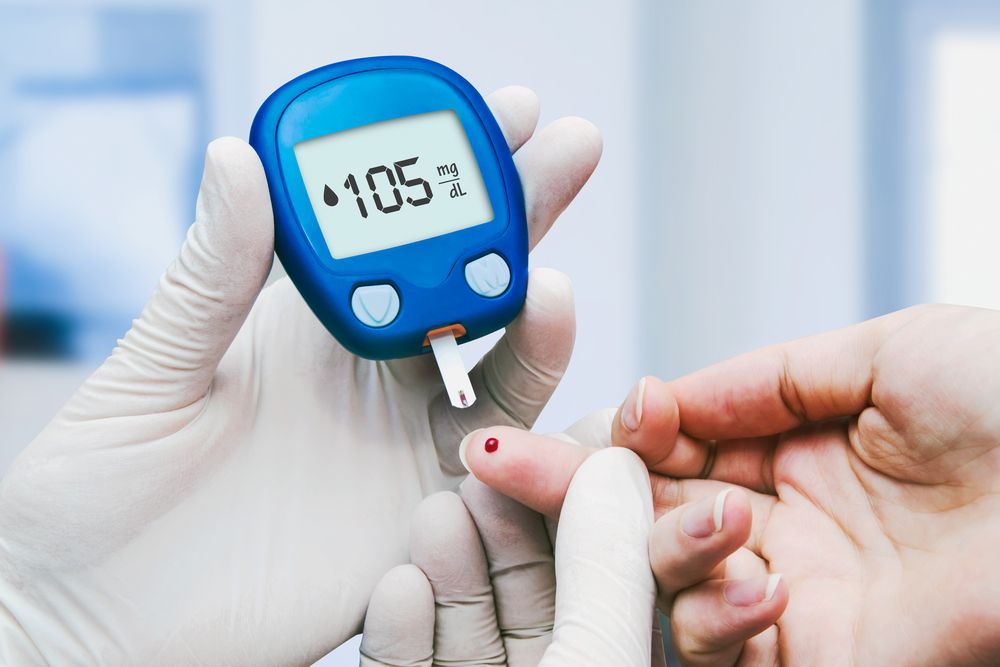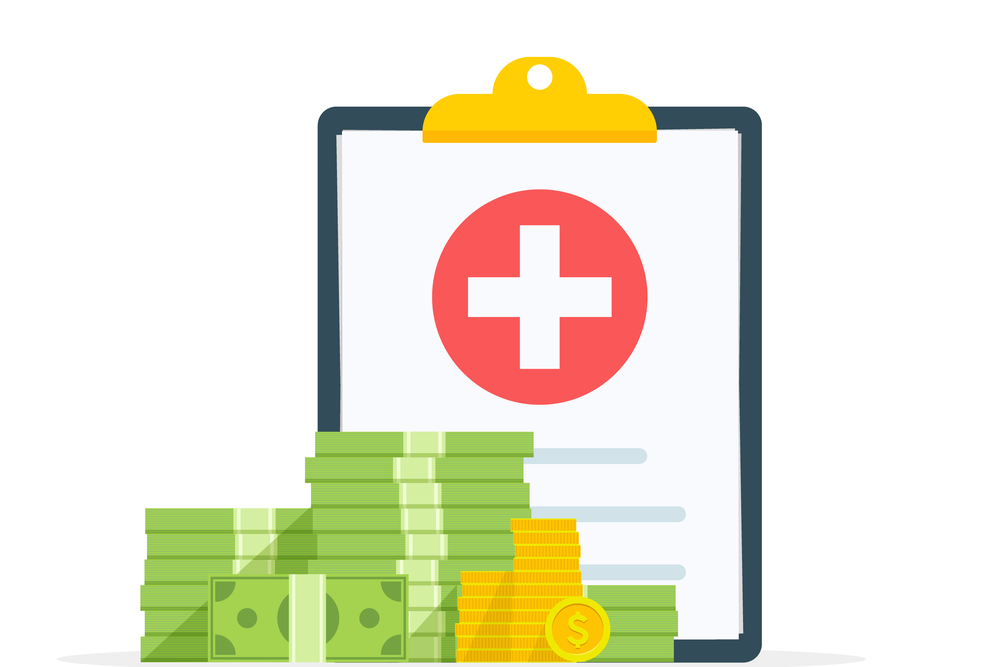Diabetes is a condition where there is either too little or too much of the hormone insulin, leading to a buildup of sugar in the blood, which can lead to a number of serious problems in the body. (Learn More, What Is Diabetes?)
For genetic and socioeconomic reasons, some ethnic groups are more susceptible to the risk factors of diabetes than others. (Learn More, Diabetes Demographics) The condition can be largely treated with exercise and dietary control, but many patients need insulin therapy and other medications to bring their blood sugar levels into balance. (Learn More, Medications for Diabetes)
What Is Diabetes?
The Centers for Disease Control and Prevention explains that diabetes is a medical condition that results when the body cannot properly process digested food to use as energy.
Under normal circumstances, the food we eat is converted to sugar (glucose) to fuel our bodies. This is done via the pancreas, the organ that produces the insulin hormone. Insulin introduces glucose into the cells in our bodies, which helps the cells carry out their functions.
Diabetes is the state when the pancreas does not produce enough insulin, does not produce any insulin at all, or the body cannot use its current insulin store as efficiently as it should. This means that instead of being put to work, sugars build up in the blood, ultimately causing serious and life-threatening health issues, including:
- Kidney failure.
- Blindness.
- Heart disease.
- Amputations of the lower extremities.

Diabetes is one of the 10 top leading causes of death in the United States, killing more people than influenza and pneumonia, kidney disease, and suicide. In 252,806 recorded deaths, diabetes, or complications stemming from diabetes, was listed as a contributing factor.
Type 1 and Type 2
Type 1 diabetes is also known as juvenile-onset diabetes, and it may account for upward of 10 percent of all diabetes diagnoses. Its risk factors are less understood than the risk factors for type 2 diabetes, but it is established that environmental, autoimmune, and genetic conditions play a role.
Type 2 diabetes used to be known as adult-onset diabetes or non-insulin-dependent diabetes mellitus. As much as 95 percent of all the people in the United States who have diabetes will have type 2 diabetes.
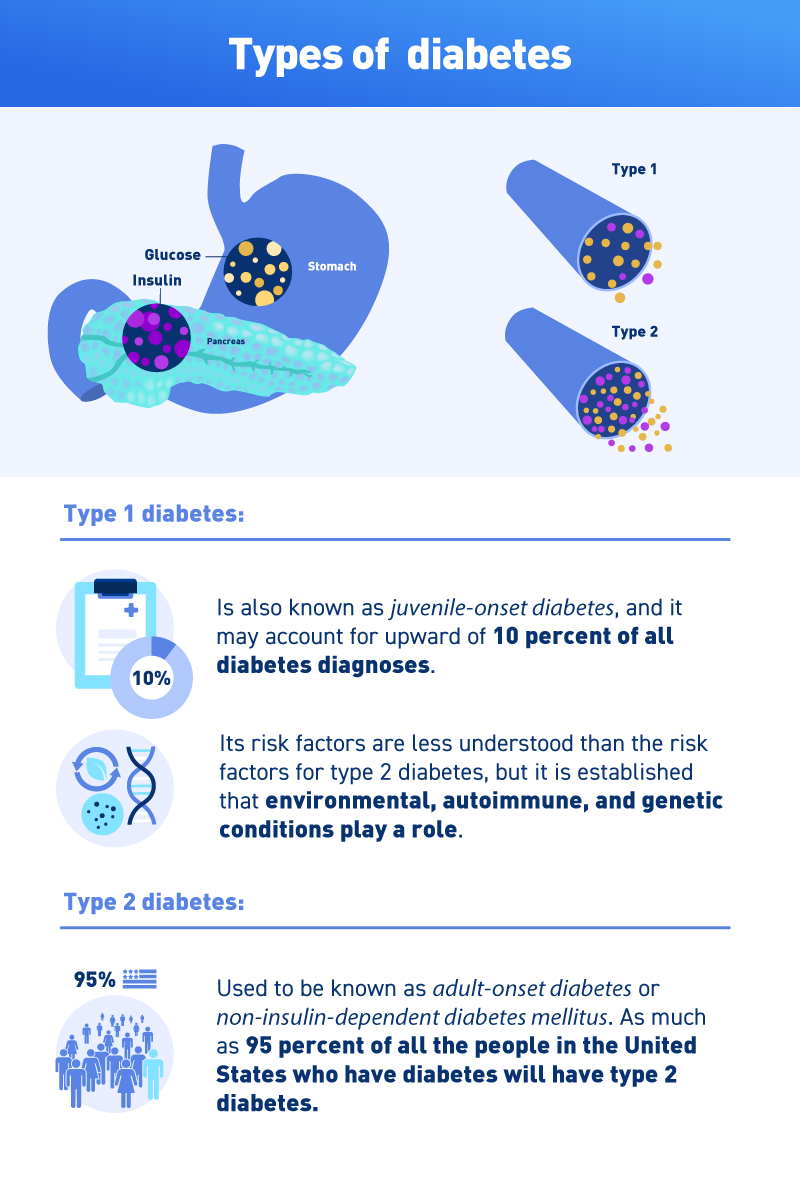
Its risk factors include obesity, older age, family history of diabetes, reduced glucose tolerance, and physical inactivity. The following racial/ethnic groups are more likely to develop diabetes:
- African Americans
- Native Americans
- Some Asian Americans
- Pacific Islanders
- Hispanic/Latino Americans
A less common type of diabetes is gestational diabetes, which is found in 5 percent of all pregnancies. It usually develops in certain women because their bodies cannot overcome the insulin resistance that can occasionally arise during pregnancy. As a result, gestational diabetes typically resolves itself at the conclusion of the pregnancy (hence the name).
As with type 2 diabetes, gestational pregnancy is found more in people with certain racial/ethnic backgrounds (African Americans, Native Americans, and Latinx Americans), as well as in people who have had diabetes in their family. Obese women are also at a higher risk for developing gestational diabetes.
Even after the gestational diabetes resolves itself, it increases the risk for a woman to develop type 2 diabetes later in life, by as much as 40 percent.
Treating type 2 diabetes usually involves a program of exercise, diet control, testing blood glucose levels at home, oral medication, and insulin injections. Around 40 percent of patients who have type 2 diabetes will need regular insulin injections.
Research has suggested that regular exercise and diet control can drive down the risk of diabetes developing, even in people who have a family history of the condition.
Diabetes Demographics
Diabetes is found more commonly in African Americans than white Americans, almost 1.7 times as frequently, and more so in African American women than white women. In 2017, a study published in JAMA found that “biological risk factors accounted for most of the health disparity.” These risk factors included waist measurement, body mass index, glucose levels, blood pressure, and lung function.
Researchers noted that there were also differences in environment, lifestyle, socioeconomic elements, and psychosocial factors (such as access to health care and health insurance) between black study participants and white study participants, which could have contributed to the disparity in rates of diabetes diagnoses. These differences were not as pronounced as the biological risk factors.
Furthermore, African Americans with diabetes have a greater risk than non-Hispanic whites to experience more negative outcomes, such as a greater range of disabilities (like adult blindness), an increased risk of heart disease, and stroke.
The mortality rate for African Americans with diabetes is 27 percent higher than that of white Americans with diabetes.
Regardless of demographics, diabetes is widespread. According to the American Diabetes Association, there were 30.3 million Americans with diabetes in 2015. Of that number, as many as 7.2 million are undiagnosed. Every year, 1.5 million new people are diagnosed with diabetes.
Symptoms and Risk Factors
Diabetes shows its symptoms in some very distinct ways:
- Frequent urination
- Unexpected weight loss
- Excessive thirst and hunger
- Itching and yeast infections (Too much sugar in the blood and urine nourishes the yeast fungus, which can irritate the skin and lead to infections.)
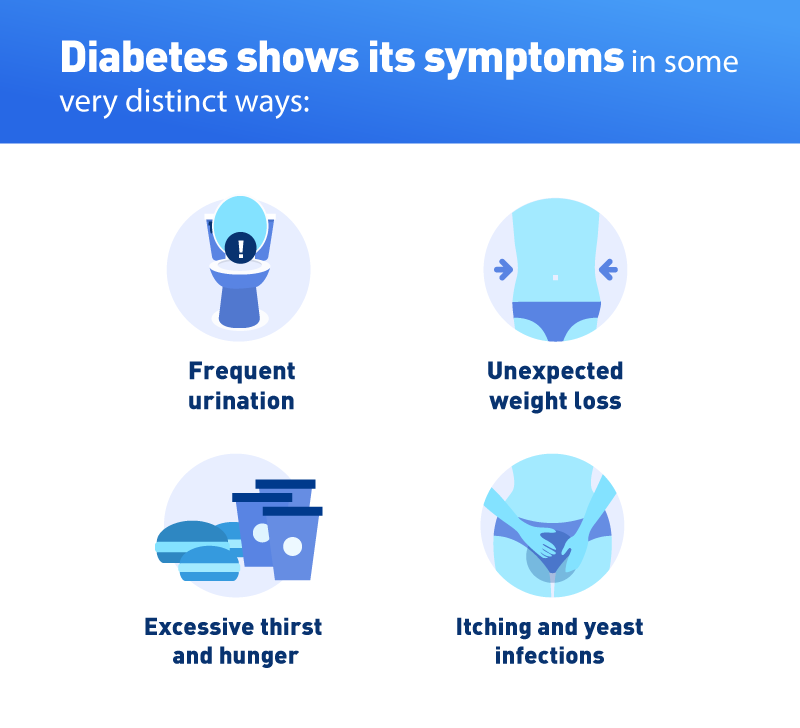
In more serious cases, some people experience a change in their vision, tingling or numb sensation in their hands or feet, dry skin, and fatigue. Insulin-dependent diabetes comes with nausea, vomiting, and stomach pains.
WebMD writes of other risk factors for type 2 diabetes, which include high blood pressure, high levels of blood triglyceride (fat), a diet high in fats and carbohydrates, high alcohol intake, and a lack of movement and exercise.
American Family Physician explains that people with type 1 diabetes are four times more likely to get heart disease, stroke, high blood pressure, nerve damage, blindness and kidney failure than people who do not have diabetes.
Patients with type 1 diabetes may also have poor circulation. Blood might not flow well through the legs and feet, which is the reason why some people with untreated diabetes have to have their feet amputated. Diabetes can even put patients into a coma (as the result of blood sugar levels that are too high or too low), and death is a possibility as well.
Insulin and Blood Sugar
A lot of people who have type 1 diabetes will take a short-acting dose of insulin with their meals. The dose is based on the calories being consumed and how physically active the patient will be in the following four hours.
For example, most patients who have type 1 diabetes will take 10 units of the insulin hormone for every 500 calories they consume (for an average daily diet of 2,500 calories). It is advised that type 1 patients take enough insulin to ensure that their blood sugar level is between 80 mg and 120 mg, with the idea of staying under 180 mg after they have their meal.
Patients can even stay on top of their blood sugar levels while they sleep. Type 1 patients should take 8 units of a long- or intermediate-acting insulin when they go to bed. The exact dosage and frequency of administration will be decided on by a doctor.
Even when patients get treatment, it is still possible for them to have blood sugar levels that are unhealthily high. This is why patients should check their blood sugar levels at least three times a day, to see how sensitive they are to their insulin hormone doses.
Food and drinks that are high in sugar levels will naturally cause insulin to spike. They should be avoided and replaced with bananas, plain yogurt, oatmeal, avocados, and other specific foods.
As a rule of thumb, patients should have food that is low in fat, low in salt, and low in added sugars. Whole-grain breads, pasta, and cereals are good for complex carbohydrates. As WebMD explains, they take longer for the body to digest, providing a steady source of energy and fiber.
Hypoglycemia
Having blood sugar levels that are too low is its own problem. This is a condition known as hypoglycemia. It can cause the following symptoms:
- Fatigue
- Difficulty concentrating
- Loss of coordination in muscles and movement
- Feeling faint
In extreme cases, some patients may even experience seizures and brain damage if their body’s blood sugar levels drop too low.
In cases of hypoglycemia, it is very important that the patient increase their sugar levels immediately, even if it means eating something that is not typically considered healthy. Cake, jam, juice, soda, or candy would suffice, but it is equally important not to overindulge and send blood sugar levels dangerously high.
Other ways that patients can keep their blood sugar levels in check are to monitor their blood pressure (keeping that below 130/85 mm HG, and even lower if there are other kidney problems), limiting cholesterol intake to less than 200 mg, and conducting regular checks of eyesight and circulation in the extremities.
It is very possible for patients with either form of diabetes to live a long and normal life. Many public figures, and even athletes, have been diagnosed with the condition. Through good diet, exercise, watching insulin levels, and regularly checking in with a doctor, diabetes does not have to be a chronic and life-ending problem.
Medications for Diabetes
While exercise and dietary control are great ways to manage blood sugar levels, medications and insulin therapies can also be very helpful. Based on a patient’s sugar levels, lifestyle, age, gender, family history, and many other factors, doctors have a variety of medications to choose from:
- Metformin: This is usually the first medication that is prescribed for the treatment of type 2 diabetes. Metformin lowers glucose production in the liver, which improves the body’s sensitivity to insulin. This helps the body use pre-existing insulin supplies more effectively.
- Sulfonylureas: These medications help the body produce more insulin. They are a class of drugs that include DiaBeta, Glynase, Glucotrol, and Amaryl. Meglitinides are like sulfonylureas, but they work much faster, and the effect they have on the body lasts for a much shorter period of time. Possible side effects include weight gain and low blood sugar.
- Thiazolidinediones: These drugs, like Avandia and Actos, work by making the tissues in the body more sensitive to insulin. They can cause weight gain and also riskier problems like anemia and heart failure. For these reasons, sulfonylureas, thiazolidinediones, and meglitinides are not usually deployed as first-choice medications for diabetes.
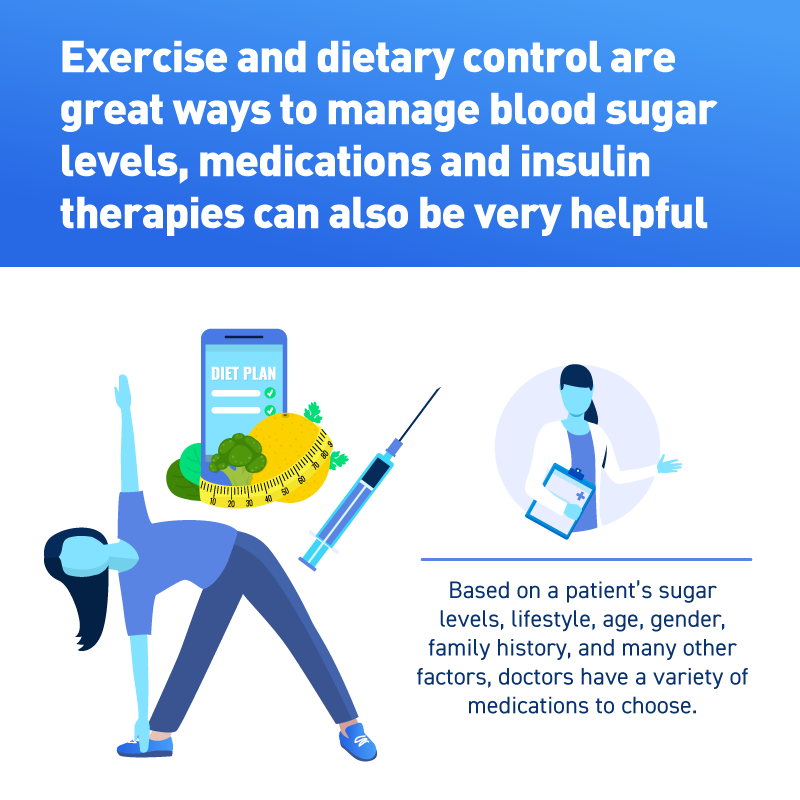
DPP-4 and GLP-1
Another class of drug treatments for diabetes are DPP-4 inhibitors. They include medications like Januvia and Onglyza. These drugs bring blood levels down, but not by very much. They are considered relatively safe and modest forms of diabetes treatments.
Weight gain is not a side effect of DPP-4 inhibitors. Patients might experience joint pain and have an increased risk of pancreatitis.
Bile acid sequestrants reduce cholesterol and blood sugar levels. They do not enter the bloodstream, so they are safe to use by patients who also have problems with their livers.
GLP-1 receptor agonists are injectable medications that slow digestion and reduce blood sugar levels. They also increase pancreatitis risk while also increasing weight and inducing nausea. Some GLP-1 receptor agonists, like liraglutide and semaglutide, might reduce the risk of heart attacks and strokes in patients who are likely to be at risk for those conditions (both of which are possibilities in cases of severe diabetes).
SGLT2 inhibitors stop the kidneys from reabsorbing sugar into the blood, instead forcing the sugar to go into urine. The medications in the SGLT2 inhibitor class (Invokana and Farxiga, among others) can lower the risk of stroke and heart attack in patients who would otherwise be at high risk for those conditions.
Women who take SGLT2 inhibitors may develop vaginal yeast infections and urinary tract infections. Low blood pressure and an increased risk of diabetic ketoacidosis are possible among both sexes.
Insulin Treatment
Lastly, there is insulin itself. Traditionally, insulin therapy for treating diabetes was reserved as a last resort. Today, the benefits mean that it is often prescribed very early in the course of treatment.
Insulin is normally injected because normal digestion of food interferes with the administration of the insulin hormone into the bloodstream.
Other ways of delivering insulin include an insulin pump, which provides small, regular doses of insulin throughout the day, and an insulin pen, which comes in either a one-shot disposable form or with a space for a replaceable insulin cartridge.
There are also inhalers, where the insulin exists in a power-like form. This method of delivery means that the insulin reaches the bloodstream much faster than other forms of delivery, but this only good for adults.
A jet injector, which works as a high-pressure spray into the skin, is an option. There is also an injection port, which is a short tube that the patient inserts just under their skin, injecting the insulin into the port. This replaces the need to have to puncture the skin every day, as would be the case with a needle.
Patients may be prescribed different types or doses of insulin throughout the day and night, each formulation of insulin working in its own way to rebalance the patient’s blood sugar levels.
Insulin and Diabetes
Patients with type 1 diabetes will benefit from insulin therapy because the pancreas of type 1 patients does not produce enough insulin on its own. Having insulin therapy in this case stimulates the cells in the body to absorb more glucose.
While type 1 diabetics will need regular doses of insulin, type 2 patients may not always have the same requirement. But unique risk factors can make it a necessary consideration.
Diabetes medications will rarely be prescribed in isolation. Doctors will also encourage patients to take low-dose aspirin, blood pressure medications, and medication to lower cholesterol, all to drive down the risks of diseases of the heart and blood vessels that are possible because of diabetes.
References
Diabetes. Centers for Disease Control and Prevention.
What Are the Leading Causes of Death in the US? (July 2019). Medical News Today.
Statistics and Facts About Type 2 Diabetes. (April 2019). MedicalNewsToday.
Normal Pregnancy — A State of Insulin Resistance. (November 2014). Journal of Clinical Diagnosis Research.
Gestational Diabetes Is an Early Sign of Type 2 Diabetes Risk. (March 2017). Women’s Health Matters.
Factors Contributing to a Higher Incidence of Diabetes for Black Americans. (January 2018). National Institutes of Health.
Statistics About Diabetes. (March 2018). American Diabetes Association.
What Are the Early Signs of Type 2 Diabetes? (September 2017). MedicalNewsToday.
Type 2 Diabetes Causes and Risk Factors. (May 2019). WebMD.
What You Should Know About Type 1 Diabetes. (November 1999). American Family Physician.
Why Is Foot Care Important if You Have Diabetes? (August 2016), Healthline.
Diabetic Coma. (August 2018). Mayo Clinic.
Meals and Insulin: Timing Is Key. (March 2018). WebMD.
How to Use Long-Acting Insulin. (April 2019). MedicalNewsToday.
How Can I Lower My Insulin Levels? (February 2018). MedicalNewsToday.
Does Your Diabetes Diet Give You What You Need? (May 2018). WebMD.
Low Blood Sugar. (February 2018). MedlinePlus.
Athletes Living With Diabetes. Everyday Health.
Type 2 Diabetes. (January 2019). Mayo Clinic.
Stroke: Diabetes and Other Risk Factors. (June 2018). Healthline.
What Are Insulin Pumps? (February 2019). WebMD.
How to Treat Diabetes. (November 2018). MedicalNewsToday.
Cardiovascular Disease and Diabetes. (August 2015). American Heart Association.

